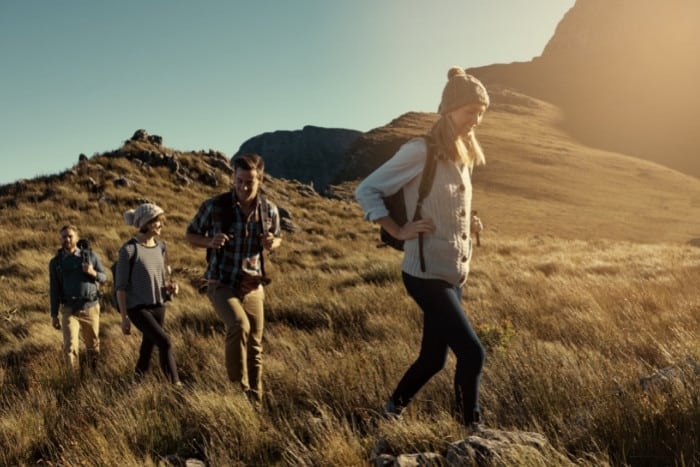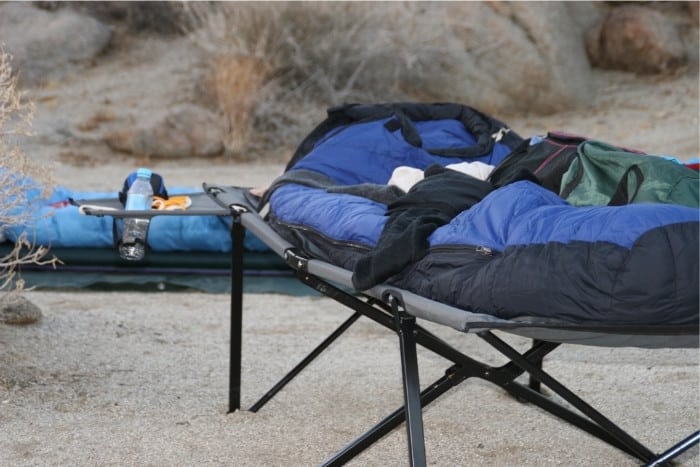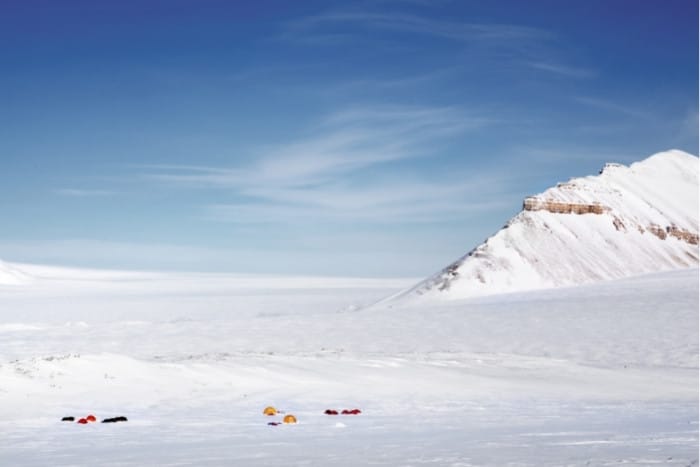Wilderness camping is a great way to get even closer to nature. Those new to winter wilderness camping may be intrigued by how peaceful it can be. New or not, wild camping is something to experience.
This comprehensive guide provides everything you need to know about winter wilderness camping. We cover exactly what wilderness camping is and some considerations for camping in the USA. We’ll recommend gear you need to pack and give you some safety tips!
Before you read on to get all the information you need, make sure when you are camping, you practice a leave no trace mentality where you respect the environment and camp sustainably.
What is Wilderness Camping?
Also known as wild camping or freedom camping, wilderness camping is all about stripping back to basics and working with what’s around you.
It’s a more primitive type of camping that usually is only accessible by foot, canoeing, bike, or skis. You enjoy every aspect of nature as you cut ties with the outside world and enter a survivalist camping mode.
Below are 5 things you need to know about wilderness camping.
1. Only Take What You Can Carry
When wild camping, your destination is likely not near a road, so you may be hiking, canoeing, snowshoeing, or skiing to your campground.
This means you are limited to what you can carry, so make sure you only bring the essentials.

2. Limited Luxuries
When you’re packing only the essentials, it’s unlikely you have much space for luxuries.
You may feel you can’t leave home without your wireless speaker, but consider how much space and weight these luxuries will add.
I find sacrificing my luxuries a freeing experience because I learn to work with what I have.
3. You Need to Prepare
You need to be as prepared as possible. You also need to consider what winter conditions will be like where you are camping, what routes may be blocked due to snowfall, and what to do in an emergency.
As the saying goes, “a stitch in time saves nine”, so it’s best to research and put in the time to ensure you’ll be well prepared.
4. Reduced Cell Service
It may be highly unlikely that you have cell service where you are camping, particularly if you are wild camping off the usual trails.
A good way to prepare for no cell service is to let someone know how long your trip is and where you plan to camp.
If there was any lesson to be learned from the book “Between a Rock and a Hard Place,” it’s to leave a note!
5. No Crowds
The best thing about wild camping is the peace and quiet. You get to avoid the crowds and bustle as you choose a camping spot that is completely your own.
Camping this way can be great for your mental health as it removes the strains of work and day-to-day worries.
What to Consider Before You Go Winter Wilderness Camping?
Now you know what winter wilderness camping is, here are some things to consider before you leap into the wild.
1. Where can you Winter Wild Camp in the USA and Canada?
You can wild camp in most National Parks and grasslands in the USA and Canada. However, in winter, there may be different rules in place for wild camping.
This might be due to limited access roads due to snow or varying conditions that recommend only experienced campers pitch up in the wilderness. It’s best to check out the rules during the winter season.
2. Permit
For some National Parks, you’ll need to ensure you have a permit to stay overnight. This could be whether you’re wild camping or not. Some permits can be free, while others will demand a fee.
It’s a good idea to check the rules and regulations of a National Park before you set out to camp in them.
3. Winter Wilderness Gear
It can get seriously cold when you’re camping in winter. It’s best to check what gear you’ll need for a winter trip before you make it as you don’t want to be unprepared for winter conditions.
Futher below we’ve made a clear list of what you need to consider packing!
4. Leave No Trace
Wilderness camping is about respecting the space and leaving it as you found it. This means taking your litter with you and burying your feces properly.
If you plan on making a campfire, try minimizing its impact on its surroundings. A popular motto to remember is: Take nothing but pictures. Leave nothing but footprints.
5. Solo Camping
It can be freeing to camp alone, but you should always check if it is safe to wilderness camp solo, depending on the destination.
Winter wilderness camping conditions can be changeable, and if you are putting yourself at risk, you may put others at risk, too, if they must help you.
What To Pack For The Winter Wilderness?
Wild camping is all about camping light. You also want to leave only your footprints behind when you leave your campsite.
For winter wilderness camping, you want to pack for the cold, so think about wearing insulating items that are also breathable.
1. Sleeping Setup
Your sleeping setup needs to include everything you’ll need for a peaceful, comfortable night’s sleep. This includes a sleeping bag and a sleeping mat.
If you’re likely to experience cold conditions, think about taking a sleeping bag liner with you and opt for a sleeping bag with more insulation.

2. Shelter
You can explore several tent options depending on where you’re camping. If you plan to hike during your camping trip, choose an ultra-lightweight tent.
Hammock tents can also be lightweight and warm. They also keep you off the ground, so you don’t have to pack a sleeping mat.
Whether you’re camping in the snow or not, it’s best to have a 4-season tent that’s waterproof.
3. Stove
When selecting a stove for your trip, you must consider how the temperature might impact its efficiency.
Canister stoves can struggle in cold temperatures, so consider a liquid fuel stove or a wood fire stove where it won’t be depressurized by the altitude either!
4. Food
Pack plenty of light, high-energy snacks, especially if you’re camping in the cold. These can be bananas, dried fruit, or nutrition bars.
For your main meals, it’s best to take the lightest possible options. These can be dehydrated food pouches or freeze-dried meals.
5. Clothing
You will need to pack clothing for any conditions. Packing for the winter wilderness could mean packing for hot days and freezing nights. Instead of packing thicker clothing, think about packing more layers.
It’s best to pack breathable and insulating clothing, so no cotton! Make sure you pack separate sleeping clothes (thermals are best), a waterproof coat, and waterproof pants.
6. Backpack
You need a lightweight backpack big enough to store all your winter camping essentials. If you’re using a new bag, test it out first and make sure it’s comfortable.
Most weight should be on your hips, with your shoulders only taking a small load. Other helpful extras on your backpack are heavy-duty zips, waterproof exterior, and hip belt pockets.
7. Water
It could be that your excursion has you in the middle of an icy desert. If so, make sure you pack enough water for your trip. If water is accessible, you will need water purification tablets to treat it.
If you will be melting snow into drinking water, exercise caution and boil it first.
8. Other Essentials
Other essentials you can’t leave behind are such amenities as a map and compass, especially if you have no cell service and trail markers that may be covered by snow.
Don’t forget toilet rolls and baby wipes, too. Taking a shower might not be possible if everything around you is frozen. Finally, never leave without a first aid kit.
This is as important as your tent; if you fail to prepare, you prepare to fail. Don’t get caught in a sticky situation without one.
10 Safety Tips
Below are our top 10 safety tips for winter wilderness camping. It’s all about being prepared and respecting the environment.
If you can master these, you are sure to make the most of what the outdoors offers.
1. What Are the Conditions Like?
Some National Parks can close at short notice if there is an avalanche or snowstorm. It’s best to double-check what conditions you could expect before you leave the house.
Most parks provide up-to-date data on conditions, and you can find reliable information on the National Park Service website.
If you’re not camping at a national park, search for other sources online that provide the latest reports on your camping destination.
2. Is the Area Safe?
It’s imperative to ask if the area you’re camping in is safe. If the area is prone to avalanches, consider taking a monitor to predict weaker layers of snow.
If it’s snowing heavily, avoid camping under trees. Heavy snowfall can weaken or break tree branches, potentially hitting your tent below.
If you’re camping near a frozen lake, make sure you camp outside the proximity of the water and not on the ice.
3. Plan for Any Weather
When you’re winter camping, be prepared for any weather. Desert winter camping could be hot in the day but icy in the evening.
At the same time, mountainous terrain may bring snow storms or blizzards.
Front country campsites are usually located with some degree of shelter, but if you are wild camping, you will have to consider how you can select a location that provides the most shelter from the elements.

4. Going To the Toilet
In the wilderness, there are some rules around going to the toilet.
If you need to poo, you’ll need to bury it at least 4-6 inches down (so make sure you pack a trowel), and it’ll need to be 200 feet away from a water source.
Also, be ready to take any used toilet paper, wet wipes, or feminine products back with you in a zip-lock bag, as this will have the least environmental impact.
5. Travel as Light as Possible
It’s best to be prepared for anything. That could mean hiking far out to find the perfect spot to pitch up. If that’s the case, you want your backpack to be as light as possible.
Make sure you pack only what you need. Your backpack will get lighter when you munch through your food and use your water, so at least that’s a bonus you can look forward to.
6. Making a Fire
If you’re camping in an area without a fire grate, fire pans or blankets are essential to protect the surrounding vegetation. You can also enclose the fire to prevent damage and always put it out after use.
7. Set Up Camp Before Dark
It can be dangerous to set up camp in the dark, so it’s best to set up your campground while there’s still enough light.
Even traveling in the wilderness after dark has resulted in accidents, such as falls on uneven ground. Unless you know the surrounding terrain well, avoid this risk.
8. Wildlife
Wilderness camping means you are actively sharing your camping space with the wildlife. It’s best to research what wildlife to expect where you’ll be camping.
In winter, it could be that most bears are hibernating, so you might not bump into them, but lynx or moose will be more common.
Be aware that you should store your food in airtight containers to avoid any animals being attracted to your camp or wandering into your tent.
9. Clean Water
Whether you pack water purification tablets or plan to use a water filter, make sure you have a way to access clean water. If you cannot access water on your trip, you must pack enough.
If you plan to use the snow as your water supply, boil it first and keep it somewhere it won’t freeze (inside your jacket).
10. Be Aware of Your Limits
Most importantly, be aware of your limits. If you lack navigational skills, consider camping where you won’t get lost. If you are camping in extreme conditions, take someone with you.
You must be aware of your limits to make safe decisions and have the most fun!
Final Thoughts
Winter wilderness camping can be a thrilling experience where you can see a different side to nature. Say goodbye to your creature comforts and get ready to experience the outdoors.
We hope this guide provides you with all the information you need to enjoy a winter wilderness camping trip. Just remember, always treat the environment with respect, and most of all, have fun!
